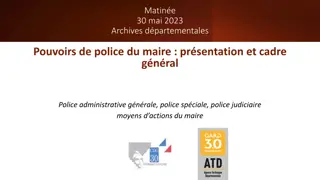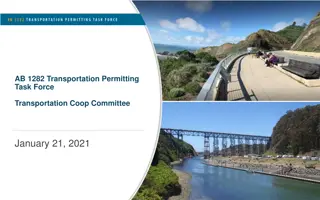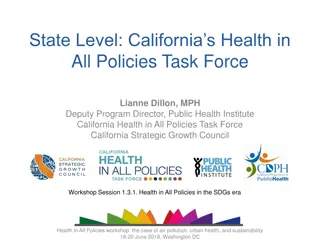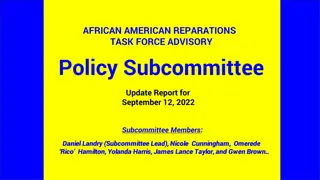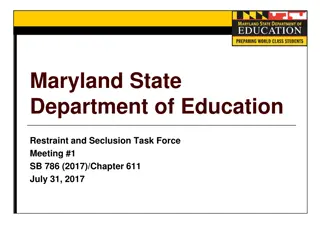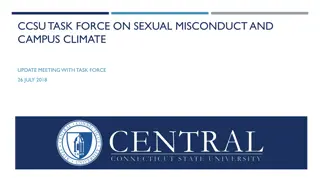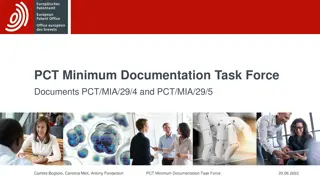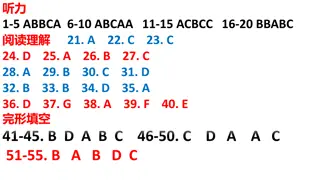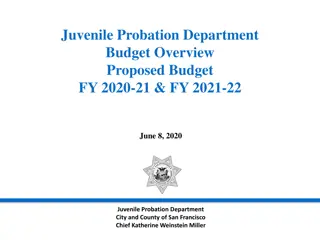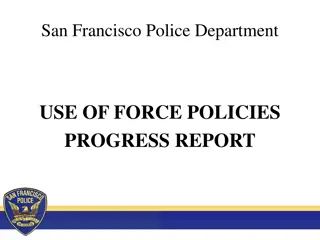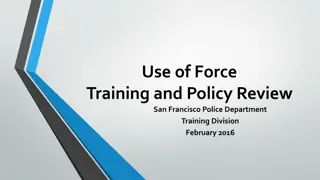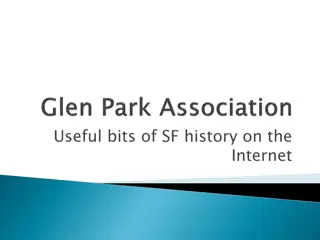San Francisco Police Department Task Force Overview
San Francisco Police Department's journey to update its use of force policy starting from December 2016, involving community meetings, drafting policies, stakeholder input, and revisions as per community recommendations. The process includes incorporating language proposed by stakeholders, changing terminology for force usage, adding sections on crisis intervention and data collection, and receiving feedback from the Department of Justice.
Download Presentation

Please find below an Image/Link to download the presentation.
The content on the website is provided AS IS for your information and personal use only. It may not be sold, licensed, or shared on other websites without obtaining consent from the author. Download presentation by click this link. If you encounter any issues during the download, it is possible that the publisher has removed the file from their server.
E N D
Presentation Transcript
San Francisco Police Department DGO 5.01 USE OF FORCE
DGO 5.01 USE OF FORCE December 9, 2016 Commission Meeting o Commission President Suzy Loftus directed the Department to draft an updated use of force policy to present to the Commission in February 2016. January 6, 2016 Commission Meeting o Commission President Loftus directed the Department to attend a series of community meetings at Third Baptist Church, Bayview YMCA, Saint Ignatius High School, and Boedekker Park, organized by the Commission and youth from the Community Safety Initiative, to obtain recommendations for the draft use of force policy.
DGO 5.01 USE OF FORCE February 10, 2016 Commission Meeting o SFPD presented three separate draft policies: Draft DGO 5.01, Use of Force Draft DGO 5.01.1, Use of Force Reporting Draft DGO 5.02, Use of Firearms and Lethal Force February 23, 2016 o Stakeholder group created and met three times to provide written and verbal recommendations to the Department on the three use of force draft policies.
DGO 5.01 USE OF FORCE The Stakeholder working group included representatives from: SFPD Office of Citizen Complaints Public Defender s Office District Attorney s Office/Blue Ribbon Panel SF Bar Association ACLU Department of Human Resources Community Representative Crisis Intervention Team working group member Coalition on Homelessness Human Rights Commission Community Safety Initiative SF Police Officers Association Officers for Justice SF Pride Alliance National Latino Peace Officers Association Asian Peace Officers Association Women Police Officers Association
DGO 5.01 USE OF FORCE May 4, 2016 Commission Meeting (cont d) The Commission agreed to draft a second version of the Use of Force policies that included: Incorporating the language proposed by community stakeholders for the opening paragraph. Using the term minimal use of force instead of reasonable force. Using the term shall, when feasible instead of should, when feasible. Using the community stakeholder s version of the paragraph regarding Proportionality. Incorporating language proposed by the community stakeholders in the section regarding the pointing of a firearm. Adding four additional factors to the list of factors that determine whether force was reasonable. Adding a section on Crisis Intervention Team in the policy. Including language to resolve issues about supervisory responsibilities when dealing with weapons other than firearms. Adding the community stakeholder suggested language about data collection requirements.
DGO 5.01 USE OF FORCE May 6, 2016 The DOJ provided a memorandum and Subject Matter Expert (SME) comments on the three Use of Force policies. The memorandum contained overall comments on the Use of Force policies and suggested: Combining the DGO 5.01, DGO 5.01.1 and DGO 5.02 into one policy Including a Definition section in the policy Including a description of the levels of force Including a list of authorized impact weapons Adding information and guidance related to the role of the supervisor Including language about use of physical controls against vulnerable populations Including cross-references in DGO 5.01 to other policies to provide adequate information Recommending that the Department review certain sections of the Final Report of the President s Task Force on 21stCentury Policing
DGO 5.01 USE OF FORCE May 6, 2016 (cont d) The DOJ memorandum also included a comment that individual SMEs made suggestions on the three separate policies. The SME recommendations came from various members in law enforcement and were summarized for the Commission by a member of the DOJ COPs Office. The memorandum and SME s comments were posted to the Commission s webpage for the public to review.
DGO 5.01 USE OF FORCE May 11, 2016 Commission Meeting Commission discussed the DOJ memorandum and SME s suggestions. Commission President Loftus announced a Use of Force subcommittee.
DGO 5.01 USE OF FORCE May 30, 2016 The Commission drafted two versions of DGO 5.01 for consideration based on the discussions at the May 4, 2016 Commission Meeting and the DOJ memorandum and SME suggestions. The two draft versions consolidated the draft versions of DGO 5.01, Use of Force; DGO 5.01.1, Use of Force Reporting; and DGO 5.02, Use of Firearms and Lethal Force.
DGO 5.01 Use of Force Draft DGO 5.01 version 1: At various places throughout the document, the terms should or should, when feasible, are used. The term should means permissive, but recommended, and allows officers more discretion when taking action. At various places throughout the document, the terms imminent, and imminent threat are used. Imminent means impending and implies that something is about to occur. At various places throughout the documents, the term reasonable force is used. Reasonable force is an objective standard of force from the perspective of a reasonable officer. This definition comes from a Supreme Court decision and is the lawful standard.
DGO 5.01 USE OF FORCE Draft DGO 5.01 version 1: Opening paragraph: The San Francisco Police Department s highest priority is safeguarding the sanctity of all human life. Officers shall demonstrate this principle in their daily interactions with the community they are sworn to serve. The Department is committed to using communication and de-escalation principles before resorting to the use of force, whenever feasible. The Law Enforcement Code of Ethics requires all sworn law enforcement officers to carry out their duties with courtesy, respect, professionalism, and to never employ unreasonable force. These are key factors in maintaining legitimacy with the community and safeguarding the public s trust.
DGO 5.01 USE OF FORCE DGO 5.01 version 1: Proportionality: The Department requires that officers use only the degree of force that is reasonable for the purpose of accomplishing their duties. The degree and kind of force used should be proportional to the severity of the offense committed or the threat posed to human life; however, the principle of proportionality does not require officers to refrain from using reasonable force to overcome a threat to the safety of the public or officers or to overcome resistance. This definition is consistent with the definition of reasonable force.
DGO 5.01 USE OF FORCE DGO 5.01 version 1: In section III, B. 3, the list of other factors that may determine reasonableness includes additional factors not included in version 2: o number of officers/subjects oAge, size and relative strength of the officers/subjects o specialized knowledge, skills or abilities of the subjects o prior contact o injury or exhaustion of the officers o proximity, access to and type of weapons available to the subject o time available to an officer to make a decision
DGO 5.01 USE OF FORCE DGO 5.01 version 1: Section IV, C includes two circumstances when it is objectively reasonable to use lethal force: 1. Protect him/herself or others from what is reasonably believed to be an imminent threat of death or serious bodily injury; or 2. Prevent the escape of a fleeing felon when: a.The officer has reasonable cause to believe that the subject has committed or has attempted to commit a violent felony involving the use of threatened use of deadly force; b.The subject poses a threat of serious physical harm to the public or the officer if the subject s apprehension is delayed; c. The use of lethal force is reasonably necessary to prevent escape; d. When feasible, some warning should be given before the lethal force is used under these circumstances.
DGO 5.01 USE OF FORCE DGO 5.01 version 1: Section V, G allows the Carotid Restraint as force option.
DGO 5.01 Use of Force Draft DGO 5.01 version 2: At various places throughout the document, the terms shall or shall, when feasible, are used. The term shall means mandatory. This language requires officers to take the action as directed in the policy, with no discretion. At various places throughout the document, the terms immediate, and immediate threat are used. Immediate means happening or existing now and implies that something is occurring at that moment. At various places throughout the documents, the term minimal force is used. Minimum force is the least amount of force needed to bring a situation or subject under control and is the standard that many in the community and community stakeholders want to use as the community standard.
DGO 5.01 USE OF FORCE Draft DGO 5.01 version 2: Opening paragraph: The San Francisco Police Department s highest priority is safeguarding the sanctity of all human life. Officers shall demonstrate this principle in their daily interactions with the community they are sworn to serve. The Department is committed to accomplishing the police mission with respect and minimal reliance on the use of force by using rapport-building, communication, crisis intervention and de-escalation principles before resorting to force, whenever feasible. The Law Enforcement Code of Ethics requires all sworn law enforcement officers to carry out their duties with courtesy, respect, professionalism, and to never employ unnecessary force. These are key factors in maintaining legitimacy with the community and safeguarding the public s trust.
DGO 5.01 USE OF FORCE DGO 5.01 version 2: Proportionality: It is important that an officer s level of force be proportional to the severity of the offense committed or the threat posed to human life for which the officer is taking action. It is critical officers apply the principles of proportionality when encountering a subject who is armed with a weapon other than a firearm, such as an edged weapon, improvised weapon, baseball bat, brick, bottle, or other object. Officers may only use the degree of force that is reasonable and necessary to accomplish their lawful duties.
DGO 5.01 USE OF FORCE DGO 5.01 version 2: In section III, B. 3, the list of other factors that may determine reasonableness does not includes the below additional factors that are included in version 1: o number of officers/subjects oAge, size and relative strength of the officers/subjects o specialized knowledge, skills or abilities of the subjects o prior contact o injury or exhaustion of the officers o proximity, access to and type of weapons available to the subject o time available to an officer to make a decision
DGO 5.01 USE OF FORCE DGO 5.01 version 2: Section IV, C adds an additional requirement to determine if it is objectively reasonable to use lethal force: 1. Protect him/herself or others from what is reasonably believed to be an imminent threat of death or serious bodily injury; or 2. Prevent the escape of a fleeing felon when: a. The officer has reasonable cause to believe that the subject has committed or has attempted to commit a violent felony involving the use of threatened use of deadly force; b. The subject poses a threat of serious physical harm to the public or the officer if the subject s apprehension is delayed; c. The use of lethal force is reasonably necessary to prevent escape; d. When feasible, some warning should be given before the lethal force is used under these circumstances. 3. Lethal force shall only be exercised when all reasonable alternatives have been exhausted or appear impracticable.
DGO 5.01 USE OF FORCE DGO 5.01 version 2: Section V, A prohibits the Carotid Restraint as force option.
DGO 5.01 USE OF FORCE Items still open for discussion by the Commission Whether California Penal Code Section 835a should be included in the policy; it is currently in both versions. Some of the DOJ SMEs commented they did not see an issue with leaving it in; no comments from DOJ SMEs about taking it out. Whether the list of sergeant s requirements for subjects armed with a weapon should be listed in the policy or handled in training; currently the list of requirements is in both versions. Some DOJ SMEs felt this list is better addressed in training while others made recommendations to clarify the language in this section. Whether to use the term un/reasonable or un/necessary. The POA and Employee groups recommend using un/reasonable, and the community stakeholders recommend using un/necessary. Some DOJ SMEs recommend reporting all physical control over individual as a use of force, (or alternatively reporting all uses of force that exceed un-resisted handcuffing) whether or not there is an injury or complaint of pain; currently neither of those recommendations are included in version 1 or version 2. Department Use of Force SME recommends taking out the restriction against an officer raising an impact weapon over the officer s head; the current training technically teaches officers to hold the impact weapon at an angle that is raised over the officer s head. This restriction is outdated based on current training. This restriction is currently in both versions 1 and 2.
DGO 5.01 USE OF FORCE June 1, 2016 Commission Meeting Presented and discussed two draft versions of DGO 5.01, Use of Force. Announced community meetings to hear public comment on Use of Force policy scheduled for June 8thand June 15th
DGO 5.01 USE OF FORCE The Commission is taking public comment tonight on the Use of Force policies. Alternatively, members of the public can submit written comments to the Commission office via email: sfpd.commission@sfgov.org


